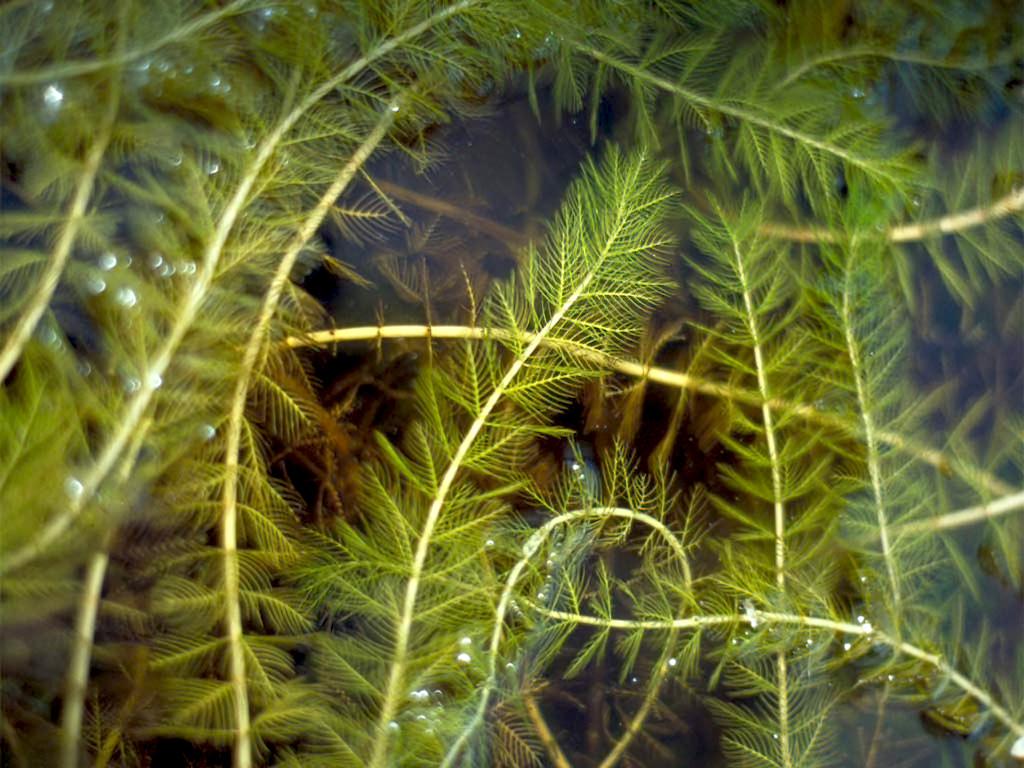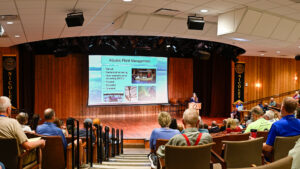Photo credit: Alison Fox, University of Florida, Bugwood.org
Researchers at the University of Wisconsin–Madison recently produced a report about lakeshore property owners’ attitudes toward aquatic invasive species management strategies. The report, which summarizes the results of a survey taken by over 700 individuals identified as owning property on a lake in Wisconsin, includes numerous insights that can help lakeshore property owners and lake association leaders make management decisions consistent with their goals.
Aquatic invasive species (AIS) are non-native aquatic species that invade ecosystems beyond their natural, historical range. They present a growing problem in Wisconsin lakes and rivers, which have seen increasing amounts of Eurasian watermilfoil and starry stonewort plants. While much is known about how these AIS spread through Wisconsin’s waterways, less is known about the impact they are having on the people who live in affected areas.
“Lakeshore property owners, despite largely not being responsible for the spread of aquatic invasive species, are often dealing with the consequences of them in their lakes,” says report co-author Bret Shaw, associate professor in the UW–Madison Department of Life Sciences Communication and environmental communication specialist with the UW–Madison Division of Extension. “We sought to examine lakeshore property owners’ perceptions of aquatic invasive species as well as the management strategies used to control or reduce them in their lakes.”
The report, funded by the Wisconsin Department of Natural Resources,found that lakeshore property owners are largely familiar with the issue of aquatic invasive species and how they spread. Over half (51%) reported hearing “a lot” about AIS, while only a small fraction (1%) reported hearing “nothing at all.”
At the same time, however, very few say they know what to do about AIS once they have become established in a lake. A quarter of respondents reported they were “not at all” familiar with ways to manage AIS once present in their lakes. These results suggest that property owners could benefit from receiving more information about how to manage AIS present in lakes.
Of the three common methods used to manage invasive plants in lakes—manual, mechanical and chemical—survey respondents were most familiar with the manual approach of pulling or raking plants by hand. A full 63% reported being at least “somewhat” familiar with this approach. The mechanical approach, which involves the use of mechanical harvesting of aquatic plants, was at least “somewhat” familiar to 59% of respondents. About a quarter (27%) of respondents reported being “not at all” familiar with the chemical approach.
The survey also assessed people’s perceptions of the risks and benefits of these three methods. The chemical approach was viewed to be the riskiest, with 48% reporting the risks “somewhat” or “greatly” outweighed the benefits. The manual approach was seen as the least risky.
“Although chemical treatment is a common strategy for managing aquatic invasive species, our research found that many lakeshore property owners view the risks of these treatments as outweighing the benefits,” says Shaw. “This may be due to concerns that herbicides targeting aquatic invasive species could also negatively impact native aquatic plants, which are an important part of the lake ecosystem.”
Reality, however, can alter the risk-benefit analysis that people do. For respondents who believe their lakes have AIS, a greater proportion agreed that chemical herbicides are worth using—even if they harm native plants—compared to other respondents.
Overall, the respondents expressed a negative view of the impact of AIS—and they aren’t optimistic things will get better. When asked to consider the current-day situation, 74% of respondents felt AIS impact their lake at least “somewhat negatively.” When asked to look into the future, the results came out about the same.
Another noteworthy finding from the survey is that respondents perceived the benefits of monitoring for aquatic invasive species as clearly outweighing the risks. This is one approach lake associations can take to make more informed decisions about what management strategies to use to address AIS on their lakes.
“It is crucial to gather insights from all stakeholders impacted by aquatic invasive species,” says report co-author Dominique Brossard, professor and chair of the Department of Life Sciences Communication. “Lakeshore owners are important stakeholders that can play a crucial role in invasive species management.”
The full report, titled “Homeowner perceptions of aquatic invasive species: Results from a survey of lakeshore property owners in Wisconsin,” is available at https://go.wisc.edu/aisreport.
This survey was conducted in October 2020 to gain insight into the beliefs and attitudes lakeshore property owners have about aquatic invasive species and their management. The survey was sent by mail to a random sample of 1,200 individuals identified as owning a property on a lake in Wisconsin, and the response rate was 63.04%. The study was conducted with funding from the Wisconsin Department of Natural Resources.
Contact: Bret Shaw, brshaw@wisc.edu
(Reprinted with authors’ permission)
Discover more from Vilas County Lakes & Rivers Association
Subscribe to get the latest posts sent to your email.




